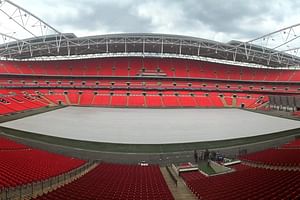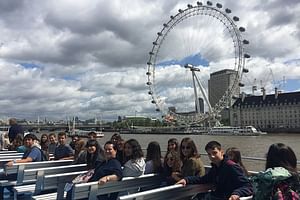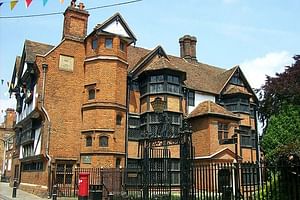-
Portsmouth is where one of the most famous figures of Victorian literature, Charles Dickens, was born. In the 19th century, this house in Regency was decorated with an idea of the Victorian Portsmouth...
Portsmouth is where one of the most famous figures of Victorian literature, Charles Dickens, was born. In the 19th century, this house in Regency was decorated with an idea of the Victorian Portsmouth. If you are a Charles Dickens lover, then, this house definitely must be seen. Look at the first home of Charles Dickens with numerous possessions and photographs, the ceramics, furniture, house artefacts, glass and decorations which have faithfully been recreated in the Regency style that Charles' parents favoured, although their properties have been dispersed for a long time. There are three furnished rooms: The lounge, the dining room and Charles' bedroom. The exhibition room features a snuff box, a tiny cup and a paper-knife and a small collection of memorabilia: The couch that he passed away on at his home in Kent, poignant memory of an author who was celebrated for his prodigious talent and his creative work.
-
Historic Dockyard is Portsmouth's number one historic and cultural heritage site full of hidden gems such as HMS Victory, HMS Warrior 1860, National Museum of the Royal Navy Portsmouth, Action Station...
Historic Dockyard is Portsmouth's number one historic and cultural heritage site full of hidden gems such as HMS Victory, HMS Warrior 1860, National Museum of the Royal Navy Portsmouth, Action Stations, HMS M.33, Boathouse 4, Royal Navy Submarine, Explosion Museum of Naval Firepower and many family sun & fun attractions such as Jolly Roger, Laser quest and the exhibition of the Horrible Histories Pirates await their visitors. We will explore all those marvels together. The history of Portsmouth's British Navy goes back 1,200 years to its beginning during the 860s under King Alfred the Great. The wide, nature-sized reservoir on the coastline is a river valley that is flooded and shielded from a deep, narrow entrance at the two sides of the dockyard. The Roman and Saxon bastions were designed to defend against the Vikings on the north side and to protect the trade. After the Norman Conquest in 1066, however, the port's first permanent fort was designed, Portchester Castle. Portsea Island was used as an army collector at Portsmouth Harbour, during the wars with France, and a small town on the south-western corner of the island was built in the late 12th century, to house workers and to support the soldiers. King Richard I granted in 1194 the Royal Charter for building a dockyard to this town called Portsmouth and in 1212 the King John guards with a wide wall. Our harbour tour includes some of the fortresses constructed over the centuries to protect Portsmouth, particularly the Round Tower at the harbour entrance and the Solent Forts, which during the Napoleonic Wars formed the core of a series of fortifications on the coast.
-
After a long morning, you will have the chance to get some free time in the lively Gun wharf Quays in the port, for shopping and dining, while Old Portsmouth harbour offers cobbled roads, sophisticate...
After a long morning, you will have the chance to get some free time in the lively Gun wharf Quays in the port, for shopping and dining, while Old Portsmouth harbour offers cobbled roads, sophisticated pubs and a small but interesting cathedral. In its Common, Clarence Pier Southsea offers more family fun you can experience. A great day out awaits you in Portsmouth today. Enjoy!
-
Admiral Nelson's HMS Victory in Trafalgar.is the most well-known warship in the Royal Navy. The Victory is best known as the flagship of the First Sea Lord and the living museum of the Georgian Navy, ...
Admiral Nelson's HMS Victory in Trafalgar.is the most well-known warship in the Royal Navy. The Victory is best known as the flagship of the First Sea Lord and the living museum of the Georgian Navy, for its role in the Battle of Trafalgar. A hand-held audio guide is used to carry the visitor's experience onboard the HMS Victory in the Historic Dockyard. Hear the sad story of Admiral Nelson with full pride, honour and success here in this spot.
-
The Royal Navy Portsmouth National Museum gives life to history. It shows artefacts from the past 350 years and explores the common themes that link the English 'Wooden Walls' sailor with today's prof...
The Royal Navy Portsmouth National Museum gives life to history. It shows artefacts from the past 350 years and explores the common themes that link the English 'Wooden Walls' sailor with today's professional crews. The Royal Navy was instrumental in shaping the world. This was the dominant naval power of Great Britain, defending its commerce from invasion or carrying out attacks abroad in turbulent times. The Royal Navy has affected thousands of people throughout the world, affected troops, women and families who have designed, served and delivered their ships and have affected the lives of communities abroad. Inaugurated in 2014, the main gallery of the Museum Hear My Story retrieves the undiscovered tales of the common men and women of the Navy, shaping the stupendous past, the century of greatest change over the last 100 years. Hear My Story takes you closer to the true Royal Navy than ever before. A cutting-edge presentation helps you to see and hear the Navy stories through war and peace. The Gallery portrays the realities of sailing struggle at sea, the Nelson Gallery discusses Nelson's lively, crowded and brief life and the Sir Donald Gosling Victory Gallery explores the history of the most famous warship in Britain from its quilting to its significant battles. The 'Trafalgar Experience' tourists will walk through the immersive, meeting Nelson and his grand enemy Napoleon, who experience the explosion of the war on the main deck of the ship. For the most comprehensive refurbishment HMS Victory has since Trafalgar, the exhibits will share historical studies that shift our view of the history of Victory, as well as new ways of protecting its future.
-
Action Stations in Boathouse 6 is an indoor high-tech, immersive attraction. The boathouse itself was built from 1845 to 1848 and was once at the forefront of design and innovation during the Victoria...
Action Stations in Boathouse 6 is an indoor high-tech, immersive attraction. The boathouse itself was built from 1845 to 1848 and was once at the forefront of design and innovation during the Victorian era, like the technology it now features inside. Action Stations features a broad selection of physical and technological challenges, simulators and tests, placing guests at the forefront of the modern naval experience. In Action Stations, visitors to the tallest indoor climbing tower of UK may reach dizzy heights.
-
HMS M.33 is not only the only British veteran of the bloody 1915-1916 Dardanelles Campaign but of the subsequent Russian Civil War. The ship is still in operation one of only three British World War I...
HMS M.33 is not only the only British veteran of the bloody 1915-1916 Dardanelles Campaign but of the subsequent Russian Civil War. The ship is still in operation one of only three British World War I warships. HMS M33 was built in 1915 at the direction of Winston Churchill, the First Lord of the Admiralty. She was a floating gun platform designed to blast seashores. The protection of the British landings in Suvla at the Gallipoli war in August 1915 was her first successful action. Until the evacuation in January 1916, she remained stationed at Gallipoli, in the Mediterranean during the rest of the war she served and in 1916 took part in the confiscation of the Greek fleet at Salamis Bay. Following the battle, the M33 was sent in Russia to Murmansk to relieve NRF before it returned to Portsmouth to be a mine-laying training ship. Her name has been renamed, HMS Minerva. Kids can involve helping the crew locate Miss Muggins, HMS M33's lovely pet.
-
Boathouse 4, a huge building with its own dock and locks, was built in 1939 in response to the need for a quick rearmament programme until WWII. It is typical of a military-industrial architecture fro...
Boathouse 4, a huge building with its own dock and locks, was built in 1939 in response to the need for a quick rearmament programme until WWII. It is typical of a military-industrial architecture from the 1930s. Boathouse 4 offers great family attraction including realistic games for children and spectacular shows. Built before the Second World War and restored, the building was converted into a training centre for boat building and will host International Boatbuilding College Portsmouth and Highbury College soon. These two colleges will educate a new generation of students in traditional design techniques and related skills still so important today for wooden boats to be built and maintained. The splendid exhibition "The Forgotten Craft" overlooking the Boatbuilding Skills Training Centre, is located within this magnificent historic building and tells the inspiring stories of small boats that formed the backbone of the Royal Navy. The Cockleshell Heroes in their canoes, the wooden cutters that powered Lord Nelson and his flagship, and powerful motorboats that helped to win the Second World War.
-
In the Dockyard Apprentice Exhibition, learn about new boat building skills and local crafts. The Dockyard Apprentice offers an immaculate experience by taking you back in time and restoration efforts...
In the Dockyard Apprentice Exhibition, learn about new boat building skills and local crafts. The Dockyard Apprentice offers an immaculate experience by taking you back in time and restoration efforts as apprentices in the early 20th century by the men who served on the Portsmouth Dockyard. Just follow the footsteps of dockyard apprentices as you learn about boatbuilding techniques and heritage crafts inside Boathouse 7. Envision 200 years of history retold through the eyes of the workers who designed the greatly dreaded battleships of the 20th century. Learn about the tales of the men who created the most fearsome float in Britain and the ingenuity behind the conventional methods of boat construction. From past to present, the boat building is back in Boathouse 4 at Portsmouth Historic Dockyard. The newest addition to the Historic Dockyard sees artisan crafts and skills from those who study it professionally in the show for everyone to enjoy.
-
Did you ever wonder about the life beneath the ocean in a submarine? Experience all your senses with the HMS Alliance, the only WW2 submarine left, and travel through its service every ten years. Take...
Did you ever wonder about the life beneath the ocean in a submarine? Experience all your senses with the HMS Alliance, the only WW2 submarine left, and travel through its service every ten years. Take a look at the works and see, hear and even smell the way life has been living under the sea. HMS Alliance is the only surviving submarine of the Second World War in Britain and commemorates the 5,300 British submariners that have died in combat. An Alliance tour starts in the front torpedo place, then through the lodging to the control room, where experienced submarine guides display the structures, including surfacing and diving. The tour proceeds through the cooking area, and through the middle of the submarine, the engine bay, until entering the back of the torpedo room, where the guides describe the evacuation of submarines in an emergency. Additionally, you can even gaze at Portsmouth Harbour through the functioning periscopes. What an experience! Silent and Secret, the Royal Navy Submarine Museum now houses a new permanent exhibition that explores the history of British nuclear dissuasion at sea. The new exhibition opens on the 50th anniversary of HMS Resolution launching. It will expose the complicated existence of these submarine operations and encourage debate about why nuclear dissuasion is introduced. Unseen and unheard of, life below the sea poses challenges. The exhibition will provide an insight into the life of the Polaris "Silent & Secret" submarines, using personal accounts and main exhibits taken from various Royal Navy National Museums, private lenders and other museums. Visitors will hear the stories and view records and personal belongings of those serving in the fleet of Polaris.
-
The Priddy Hard was remote enough to safely store up to 6,500 barrels of gunpowder from the main dockyard. Throughout the Napoleonic Wars, all the Warships of the Royal Navy, including the HMS Victory...
The Priddy Hard was remote enough to safely store up to 6,500 barrels of gunpowder from the main dockyard. Throughout the Napoleonic Wars, all the Warships of the Royal Navy, including the HMS Victory, loaded up their guns and weapons and retrieved them from small boats called 'powder hoys,' which had gathered barrels of gunpowder carrying them down the Rolling Road to the port. The platform has changed over time. When the loading arms were introduced in the late 1850s, barrels of testing powder were no longer required and a range of large magazines was created for the filling and storing of shells. In the 1880s, the construction of the narrow railway for transporting the order between the refuelling and storage buildings became required to substitute highly explosive cordite with gun powder as the propellant. The production of torpedoes, depth charges and weaponry until the arrival of guided missile in the 1960s continued through the 20th century. During the 1982 Falklands War Priddy Hard last supplied arms to the Royal Navy.
-
There is no better way of viewing Britain’s lovely naval city than from 105 metres over the Portsmouth Harbour. The Spinnaker Tower reflects the maritime history of Portsmouth by its design and its ...
There is no better way of viewing Britain’s lovely naval city than from 105 metres over the Portsmouth Harbour. The Spinnaker Tower reflects the maritime history of Portsmouth by its design and its name, a type of sail that balloons to the exterior. On the 18th of October, 2005, the Tower opened its doors to its visitors. The tower is 2 1⁄2 times higher than Nelson's Column at a height of 560 feet (170 m), which makes it one of the tallest structures accessible in Britain outside London. Around Portsmouth, the tower is visible and dominates the skyline of Portsmouth. The Tower can be also seen from Isle of Wight, the Manhood Peninsula and even Highdown Gardens in Worthing. At the top is a triple observation deck with a 360 ° view of the city of Portsmouth and the Harbours of Langstone and Portsmouth, as well as 23 mi (37 mi) of viewing range. The tower originally named the Millennium Tower in Portsmouth, was built in 2000 to welcome the Millennium. Construction did not begin until 2001 and was completed in mid-2005 because of the political, financial, contractual and construction problems and additional funding requests of Mowlem builders. The tower was renamed Spinnaker Tower due to the six-year delay in its completion and not as expected for the Millennium. As the landmark in South England, Spinnaker Tower is used in the titles series of the news programme BBC South Today. It is also available on ITV News. Today we will take you to this iconic tower of Portsmouth. For the thrill seekers, virtual altitude experience is also another attraction as well as a real fearful experience of abseiling with an extra charge in Spinnaker Tower in Portsmouth.















































